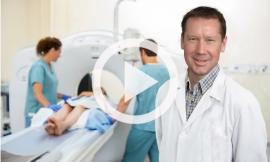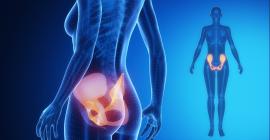Welcome to the CBMD Online Accreditation Program
Dr. David Lyons, Chair OAR CBMD Facility Accreditation Program

Every Ontario facility providing BMD services is encouraged to seek CBMD Facility Accreditation. The benefits to facilities begin with the commitment to a standard of excellence for BMD testing to ensure optimum patient care.
The OAR CBMD Facility Accreditation Program continues to evolve to ensure that accredited sites provide the highest standard of BMD services in Canada. It also continues to recognize DXA scanning as an area of imaging requiring additional ongoing investment in QA/QC to further the diagnostic needs of patients.
The New Online CBMD Program
The CBMD team has developed as a two-pronged program – a facility quality control and quality assurance program and a continuing education component for medical specialists reporting BMD and the technologists providing BMD services.
The new online program is the latest evolution of this vital QA/QC initiative. The primary goals are to:
- Accredit every BMD site in Ontario and BMD sites outside of Ontario committed to meeting the CBMD standards
- Continue mandatory involvement of qualified medical physicists who play a vital role in ensuring QA/QC
- Keep accreditation costs consistent with Mammography Accreditation
- Work closely with referring family physicians.
- Encourage every BMD technologist in Ontario (and those in other jurisdictions who may seek CBMD Facility Accreditation) to obtain Accredited Densitometry Technologist (ADT) designation as ADT designation is a mandatory requirement for CBMD Accreditation
- Continue to enhance educational programming for both reporting imaging physicians and technologists providing BMD services since there can be NO accreditation without education.
The core elements of CBMD Facility Accreditation remain unchanged. They include standardized reporting for BMD; a uniform standard for QA/QC; mandatory involvement of medical physicists and ongoing education as a cornerstone of accreditation.
Improved Educational Programming for Reading Physicians & Technologists
A core part of the educational programming is focused on acknowledging and understanding the vital partnership between imaging physicians and technologists and promoting the enhanced joint-education of both whenever possible and appropriate.
We want, and need our technologists to be the best in any jurisdiction, and in many modalities. It is for this the reason that the OAR has included technologist training in concert with imaging physicians for the majority of our CME programs, particularly BMD, where technologists play such a vital role.
Physicians and technologists now have separate CBMD programs dedicated to topics relevant to their educational needs – for reporting physicians we are focusing on QA/QC and reporting. We have committed to providing workstation case-study workshops and on-line case studies. For technologists we have committed to provide hands-on positioning workshops; courses on developing QA/QC programs and the production of on-line education courses and webinars.
Standard Reporting Tool for Physicians
To further enhance physician reporting of BMD, a standard reporting tool based on the CAR’s reporting guidelines is under development that will be introduced in 2015. This will ensure consistency of reporting and will take accreditation to a new level in Canada.
The OAR CBMD team will continue to work with the Royal College of Physicians and Surgeons of Canada (RCPSC) and the Canadian Association of Medical Radiation Technologists (CAMRT) to ensure that it provides the highest standard of BMD educational training in Canada for reporting physicians and technologists providing BMD services.
Why Every BMD Technologist Needs CBMD Accredited Densitometry Technologist (ADT) Designation!
The ADT was developed and introduced in 2010 as part of the CBMD’s commitment to continually improve training and review and enhance standards of operation relating to patient care. Many physicians and technologists had asked for a reasonably priced “made in Canada” program that reflects the needs of our publicly funded health care system, as well as economic restraints and the high cost of training available outside the country.
The OAR’s CBMD ADT is the only BMD accreditation program for technologists in Canada. The ADT program recognizes the vital partnership between imaging
A deficiency in training can result in mistakes both with scan acquisition and analysis and this ultimately will affect scan interpretation. DXA studies that are performed incorrectly will contribute to major mistakes in diagnosis and therapy. The more knowledgeable the technologist, the greater the benefit to the patient and to the reporting physicians!
An evaluation of the CBMD program prepared in conjunction with a U of T research team demonstrated:
significant improvement in the quality of scanning provided by initial pilot project sites from the time of their initial application compared to services provided in 2010
The CBMD has also documented in its most recent ADT CME in November 2014 that the highest grades on written examination and practicum submissions were achieved by those technologists working at previously accredited sites.
This is a testimony to the value of the ADT program, which has been developed and is taught by physicians, technologists and physicists, all knowledgeable in quality control and DXA scan acquisition and analysis.
Program development has been based on the principal that the technologist is pivotal in achieving a high quality of patient care. It teaches the importance of precision and determination of LSC (least significant change) for the facility. It also teaches phantom scanning and calibration; graphing QC data with Shewhart’s rules; the importance of routine DXA equipment service; Quality Assurance with emphasis on DXA acquisition (with attention to patient positioning); and scan analysis. A special effort is made to educate the technologist regarding the BMD Questionnaire in determining patient risk factors for bone loss that are indications for BMD testing and those risk factors important to the determination of 10-year absolute fracture risk.
ADTs will have some understanding of osteoporosis and they will have knowledge of the risks for the disease. They will achieve expertise in the performance of DXA and will be better able to communicate relevant history to the reporting physician based on their knowledge of the osteoporosis questionnaire. And, of great importance, the ADT will also be able to address issues related to Facility Accreditation.
The CBMD ADT Program is a low-cost, high quality made-in-Canada program especially designed for BMD technologists that is available as both a live program and a live webcast. It provides technologists the opportunity to demonstrate and validate their competency. More than 300 technologists from sites across Canada have already earned their ADT designation.
Join the growing ranks of hospitals and facilities that have already earned CBMD Facility Accreditation and register your site now.
Dr. David Lyons, Chair OAR CBMD Facility Accreditation Program





